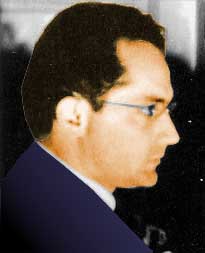
|
America's Schindler
By Richard Z. Chesnoff
Marseilles --- There is no memorial to Varian Fry in this busy French port city.
But the quiet American
Fry - whose story reads like a movie script - was a preppy
journalist who pulled off one of the war's most dramatic escapes.
Under the eyes of both France's collaborationist Vichy regime and
its Nazi patrons, Fry and a small group of helpers managed to
smuggle more than 2200 people out of Marseilles, across the French
border to the safety of neutral Portugal and then the US. His
"clients list" read like a Who's Who of European creativity:
painters Marc Chagall and Max Ernst, sculptor Jacques Lipchitz,
writers Franz Werfel and Hannah Arendt, musician Wanda Landowska
just to name a few.
The son of a New Jersey stockbroker, Fry had personally witnessed
Nazi savagery on a 1935 reporting trip to Germany. Later, he
jumped at a chance to return to Europe to save people trapped in
conquered France. With help from US backers, Fry landed in
Marseille in 1940 with $3000 strapped to his leg -- just enough
to set up his "American Rescue Committee". He was 31.
The Mediterranean city was crammed with thousands of refugees who
feared they'd be arrested and turned over to the Germans. Anti-
Nazis - Jews and non-Jews - were tops on Hitler's wanted list and
the Vichy was eager to please. Posing as a YMCA relief worker by
day, and working as an underground railroader by night, Fry and
his small band of devoted helpers defied the authorities,
hustling up fake passports and visas, and slipping people out on
small boats or by foot across mountain trails.
Among Fry's closest associates: a beautiful Chicago born heiress
named Mary Jayne Gold who'd come to Paris in the early Thirties
"to have a good time". When the Nazis marched down the Champs
Elysees in 1940, Gold headed south to Marseilles where she met
Fry. "He was a Harvard man and a bonafide WASP just like me," she
told me before she died last year. Gold helped finance Fry's
operation and often used her beauty to coax officials into
closing their eyes to the rescue work.
Shamefully, it was the US State Department - which wanted to
maintain "good relations" with the Vichy French - that helped
block Fry's work. The US consulate confiscated his passport, and
connived with the French fascists to have him expelled from
Marseilles for the crime of protecting "Jews and anti-Nazis".
Bitter, Fry returned to the US and tried to set off warning bells
about the Holocaust he saw coming. But he remained under a cloud,
and even after Pearl Harbor, his talents and energy were never
utilized by the US war effort. With time he slipped into
obscurity and in 1967, he died alone in Connecticut where he was
teaching high school Latin.
In recent years, there's been an attempt to honor Fry -- albeit
belatedly. He received a French Medal of Honor shortly before his
death and posthumously became the only American ever honored at
Jerusalem's Yad vaShem Memorial. More recently, both Washington's
Holocaust Museum and the Jewish Museum in New York held Fry
exhibits. But sadly and unfairly he has been largely forgotten,
especially here in France where no memorial honors him -- no
statue, no plaque.
American author John Hunt, who now lives with his beautiful wife
Chantal in the medieval town of Uzes north of Marseilles, is one
of those - like myself - who believe the time's come to correct
this blemish on history. In this prolonged season of revisiting
just who did what to whom in World War II, the US government
would do well to sponsor a Varian Fry Memorial and exhibit in
France. The idea deserves solid backing from organizations like
the World Jewish Congress, the Anti Defamation League and the
Wiesenthal Center. Above all, it's a golden opportunity for the
French, who 53 years after the war are finally coming to terms
with the Vichy sins from which Varian Fry helped save so
 remains one of its great World War II
heroes.
remains one of its great World War II
heroes.
1/30/98: A last chance for the Mideast?
1/11/98: The Moment for Restitution Has Arrived